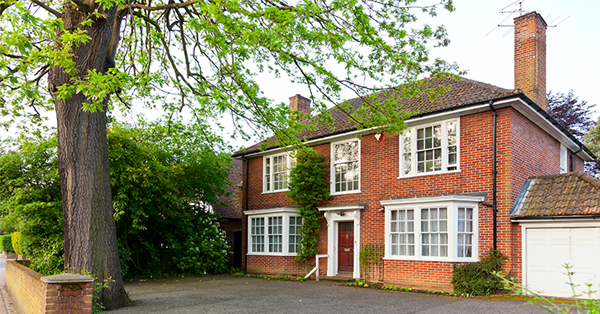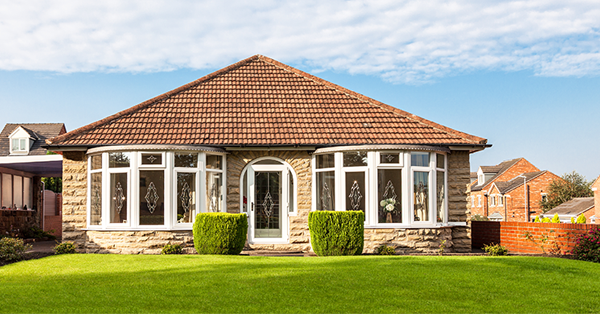Which Improvements Add to Your Home's Value?
- Market tastes differ over time; speak to your local estate agents to find out what features you could add that are in high demand.
- Top Tip: Review the current market with agents in your area and assess the average price and what other properties are selling for.
- Adding a legal bedroom in a loft conversion can add value to your home up to 20%.
- When you redecorate inside your home, potential buyers are more likely to see it as regular maintenance rather than an upgrade.
Home improvements can not only make your home a better place to live in but they also can increase its resale value greater than what you paid for them. The question is which improvements add the most amount of value (or any value at all!)?
The rule of thumb is more living space = more value, however, don't forget the costs involved when extending your living or storage space and the formal process required to be followed with planning permission and building regulation approval.
How much value can home improvements make?
In our table below, we examine which home improvements add to your property's value and compare them in terms of probable return on investment.
The caveat is that market tastes never stand still: you should always do as much research as you can about what is currently in vogue and what improvements are likely to stand the test of time.

Return on investment (ROI) for home improvements
If you are completing improvements to make more money then before starting you should make sure that the amount you are going to invest will be returned with an increase in the property's value.
The best way to do this is to review the current market with estate agents in your area and assess what other properties are selling for or are under offer that are currently in a similar condition and size to what you are looking to achieve.
Skip to read about the home improvements in more detail.
Home Improvement | Loft conversion |
Costs Involved | Plan drawings and application, architects (if required) detailed drawings, building labour and materials. |
Planning permission or building regulations approval? | Planning permission (either under permitted development or normal application) and building regulation approval. |
Do these improvements add value to your property? | Yes - can be up to a 20% increase in value. |
Home Improvement | Extension (single-storey, double-storey) |
Costs Involved | Plan drawings and application, architects (if required) detailed drawings, building labour and materials. |
Planning permission or building regulations approval? | Planning permission (either under permitted development or normal application) and building regulation approval. |
Do these improvements add value to your property? | Yes - can be up to a 25% increase in value. |
Home Improvement | Wine Cellar |
Costs Involved | Building labour and materials. |
Planning permission or building regulations approval? | Planning permission and building regulation approval. |
Do these improvements add value to your property? | Potentially - can be up to a 30% increase in value. |
Home Improvement | Garage conversion |
Costs Involved | Building labour and materials. |
Planning permission or building regulations approval? | Planning permission and building regulation approval. |
Do these improvements add value to your property? | Potentially - can be up to a 10%-20% increase in value depending on the type of conversion. |
Home Improvement | Parking space (non-garage) |
Costs Involved | Purchase cost for land or for creating a whole new driveway. |
Planning permission or building regulations approval? | Planning permission (viewed as changing the view of the street). |
Do these improvements add value to your property? | No |
Home Improvement | Land purchase |
Costs Involved | Cost to purchase land, solicitors' legal and estate agent fees, land surveyor fees. |
Planning permission or building regulations approval? | N/A |
Do these improvements add value to your property? | Yes - can be up to a 10% increase in value. |
Home Improvement | Change internal structure (non-extension such as removal of load bearing walls ) |
Costs Involved | Cost of structural engineers, building labour and materials. |
Planning permission or building regulations approval? | Building regulation approval |
Do these improvements add value to your property? | No |
Home Improvement | Central Heating including new boiler and radiators |
Costs Involved | Building labour and materials. |
Planning permission or building regulations approval? | Building regulation approval. |
Do these improvements add value to your property? | No |
Home Improvement | Double Glazing |
Costs Involved | Building labour and materials. |
Planning permission or building regulations approval? | Building regulation approval/FENSA. |
Do these improvements add value to your property? | Yes - can be up to a 10% increase in value. |
Home Improvement | Replace kitchen or bathroom |
Costs Involved | Building labour and materials. |
Planning permission or building regulations approval? | Building regulation approval. |
Do these improvements add value to your property? | No |
Home Improvement | Internal Redecoration |
Costs Involved | Building labour and materials. |
Planning permission or building regulations approval? | N/A |
Do these improvements add value to your property? | No |
Home Improvement | Pebble-dashing, white-washing etc. |
Costs Involved | Building labour and materials. |
Planning permission or building regulations approval? | Planning permission if changing the 'look' or if in a conservation area/listed building. |
Do these improvements add value to your property? | No |
Home Improvement | Gardening |
Costs Involved | Plan drawing and application, drawing if required (architect), building labour and materials. |
Planning permission or building regulations approval? | Planning permission sometimes for work at the front of the house. Decking at the front may require planning permission and building regulation approval. |
Do these improvements add value to your property? | Potentially - can be up to a 20% increase in value. |
Home Improvement | Rewiring |
Costs Involved | Plan drawing and application, electrical contractor labour, material costs. |
Planning permission or building regulations approval? | Building regulation approval. |
Do these improvements add value to your property? | No |
Home Improvement | New Carpet or wooden flooring |
Costs Involved | Building labour and materials. |
Planning permission or building regulations approval? | N/A unless it's a listed building. |
Do these improvements add value to your property? | No |
Which improvements give the greatest return?
Parking space, buying land adjoining your property
The UK is plagued in many areas, particularly urban, by a shortage of parking spaces with people even being prepared to buy standalone leasehold garage space. This means if you convert a space to park a car in it - it would normally be your front garden - you stand to add to your home's value. How much so - and therefore whether you'd make a return on your investment - depends on how popular parking in your area is.
Buying land adjoining your property can similarly make your home more valuable and this increases in proportion to how much land you buy. Once again, how large a return you'd make on what you buy depends on the behaviour of land prices in your area.
The regulations
The parking area must be entirely within the boundary of the property to allow pedestrians to pass the car safely. This is especially important for people with pushchairs, wheelchair users, people with limited mobility or blind/partially sighted people. If a car overhangs the pavement, you may be prosecuted.
The minimum size for a single-car parking space is 5.0m by 2.5m, excluding the space needed for any swing gates, access to bins etc. Some family cars today are 5m long. For this reason, the council encourages parking bays in front of houses that are larger than the above standard.
Also, as referred to in the table above, if you are creating a parking area at the front of your property, and there isn't one in place already, you will have to apply to your local planning department to create a vehicle crossing/dropped kerb and you have pay for your application and the cost of building it.
You may also have to pick your contractors from an approved list picked by your local council. If any street furniture, such as street lighting, needs to be relocated as a result of installing your dropped kerb, you will have to pay for this also.

Modifying your living space (excluding extensions)
You have the option to put in a stud wall to divide up a master bedroom or large room into an extra bedroom, dining room or two smaller rooms. Creating more bedrooms, such as a loft conversion, as long as they are of usable size and provide enough roof space, can increase your property's value if your area is popular with families. If the area is popular with professionals who don't have children, you would see less of an uplift in your property's value.
You should still consider carrying out this kind of project if it adds to your quality of life, regardless of potential future returns on sale. The same argument could be made for doing the opposite, i.e. knocking down a stud wall to create one large room out of an existing layout of two smaller rooms, or turning a loft conversion back into a storage facility.
However, if you choose to do this, you need to be sure you don't knock down a load-bearing wall without taking the advice and direction of an expert.
Adding central heating, double glazing, rewiring, re-plumbing
These jobs, if done throughout the whole property, will increase the value of your property, particularly if the work counts as necessary modernisation, and the uplift may exceed your outlay. Homes that need these kinds of works will be non-modern properties aged more than around 30 years.
Although less obvious value-additions than structural expansions, these projects benefit from being less expensive and you often don't need separate planning permission, although it always pays to check with the relevant local planning authority.
Doing these projects in small 'dribs and drabs', fitting a radiator here and there for example, is not likely to add value to your home much but once again, the improvement work may improve your quality of life.
Integrating smart home technology can be a significant selling point. Automated lighting, heating systems, and security features offer convenience and can make your home more energy-efficient. These technologies are becoming increasingly desirable, particularly among tech-savvy buyers and could add considerable value to your home.
Pebble-dashing, white-washing etc.
The danger of looking at these kinds of works as an investment where you'll see an eventual return on costs is that they are very much a matter of taste and tastes change rapidly and unexpectedly.
However, most experts would agree that having a smart exterior to your house generally helps sell your home (first impressions are important), so it's worth ensuring that whatever frontage your house has is well-maintained.
Replace kitchen, replace bathroom
Once again, maintenance of these areas will increase your quality of life but the work will deteriorate with time and many people will judge the work as simply necessary upkeep.
You also have to bear in mind that many people move into a new property and decide to refit the kitchen and/or add a new bathroom suite (such as a downstairs bathroom), to personalise their home. Therefore, your work, other than making the place look neat, may not be a factor. We would advise you not to view these works as likely to give you a return on your costs.

Painting, wallpapering, redecorating
When you redecorate inside your home, potential buyers are more likely to see it as regular maintenance rather than an upgrade. Avoid redecorating in a way that is too unusual for most people's tastes, as this could decrease the value of your property.
However, a fresh coat of paint does go a long way and is one of the more cost-effective ways to transform a room. It can make rooms appear brighter, cleaner, and more modern. Neutral colours are appealing to possible future buyers and can be seen as a blank canvas for them to personalise, therefore adding some value to your home before the sale.
Bear in mind that poorly executed paint jobs can detract from your home's value rather than add value to your home. Consider hiring professional painters and decorators to ensure a flawless finish, saving you time and providing peace of mind.
Home improvements like redecorating can go beyond painting and decorating. It includes updating fixtures and fittings to create a more cohesive modern look. Simply replacing old light fixtures, updating window treatments, and swapping out hardware on cabinets can add value to your home.
Gardening
Maintenance of any garden spaces is advisable in terms of selling your home at a fair price compared to other comparable properties, all other things being equal. However, in terms of cold return on investment, you would be better off converting garden space for use in an extension or to a parking space.
Bear in mind that although you won't generally ever need planning permission or building control sign-off for gardening work at the back of the house, at the front, planning permission may be required if:
- Rainwater from the impermeable hard surface of front landscaping at ground level has nowhere to run other than into a household drainage system or onto the public highway; or
- Your property is a listed building.
If you intend to install decking at the front of a maisonette or flat, you may need local planning officer permission and if this is required, you will almost certainly require building regulations approval as well.
Professional landscaping can transform your garden, making it more inviting and easier to maintain. Features like flower beds, walkways, and water features can significantly boost kerb appeal, which is crucial for making a strong first impression on potential buyers.

Energy efficiency improvements
Adding insulation to your home is a smart investment. Not only does it improve energy efficiency, but it also makes your home more attractive to eco-conscious buyers. Insulating lofts, walls, and floors can significantly reduce heating bills and increase comfort.
Installing solar panels is becoming increasingly popular. They offer long-term savings on energy bills and appeal to buyers interested in sustainable living. Government incentives and subsidies can offset the initial installation costs, making this a viable option for many homeowners.
Are you looking to sell your property?
Want help now? Call us on 0333 344 3234 (local call charges apply)
Joint owners share the costs of renovation - Who is due the increase in property value?
Where a property is jointly owned and the intention is to share the cost of building works, then any gain in the property value that relates specifically to the repair/renovation work is shared in direct proportion to the joint owner's contribution towards the works.
If the work is undertaken straightway after buying the property then this could be viewed as a Resulting Trust, however, if the improvements are made much later than the date of purchase then this may give rise to a constructive trust. The case that best explains this is Drake v Whipp in 1996.

Andrew started his career in 2000 working within conveyancing solicitor firms and grew hands-on knowledge of a wide variety of conveyancing challenges and solutions. After helping in excess of 50,000 clients in his career, he uses all this experience within his article writing for SAM, mainstream media and his self published book How to Buy a House Without Killing Anyone.
Caragh is an excellent writer and copy editor of books, news articles and editorials. She has written extensively for SAM for a variety of conveyancing, survey, property law and mortgage-related articles.









